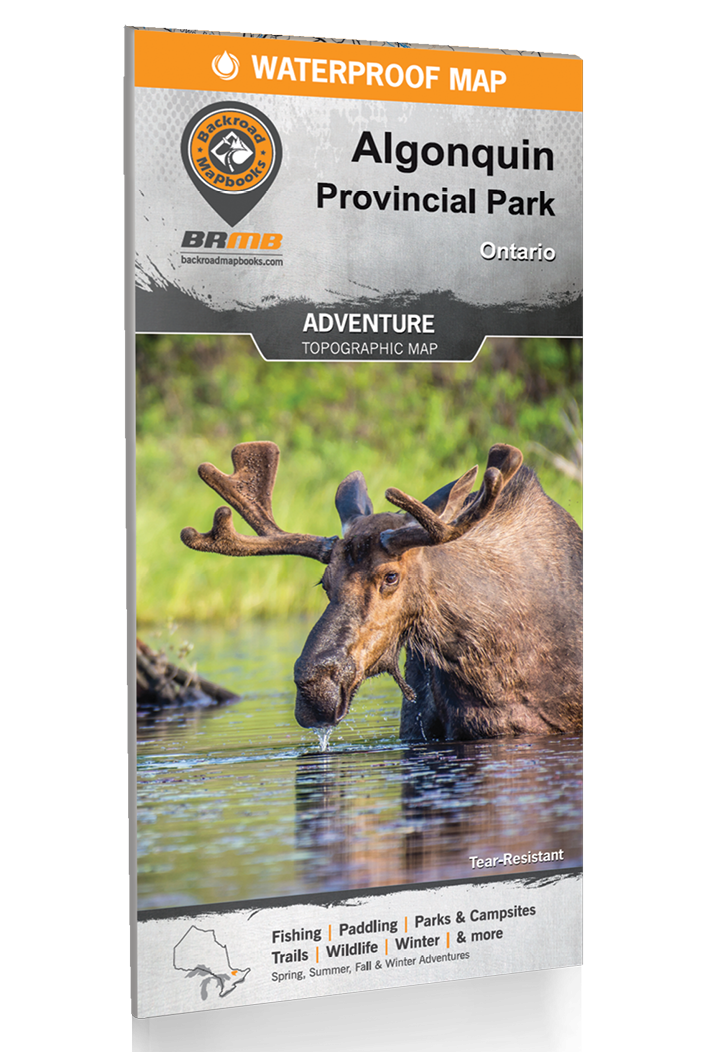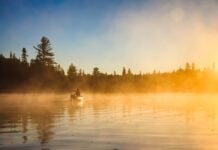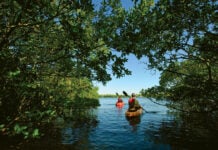Algonquin Park is just a few hours’ drive from Ontario’s largest urban centres, yet this celebrated outdoor recreation and adventure destination feels worlds away from the hustle and bustle of Toronto and Ottawa.
You don’t have to be a rugged outdoors person to experience the majestic lakes, serene forests and abundant wildlife of this iconic park. Algonquin’s diverse hiking trails, canoe routes, visitor attractions and winter recreation opportunities are easily accessible from the park’s scenic central artery, Highway 60.
Whenever you choose to visit, each season offers something special in Algonquin Park. Spring boasts peak wildlife viewing, summer is the most popular season in the park, fall colours are spectacular and winter is the quietest time of year, when dazzling white snows blanket park forests and frozen lakes.
With a wonderful range of accommodations—from campgrounds to luxury lakeside suites—Algonquin Park is a perfect staycation destination for travelers of all types.
Things to do in Algonquin Park
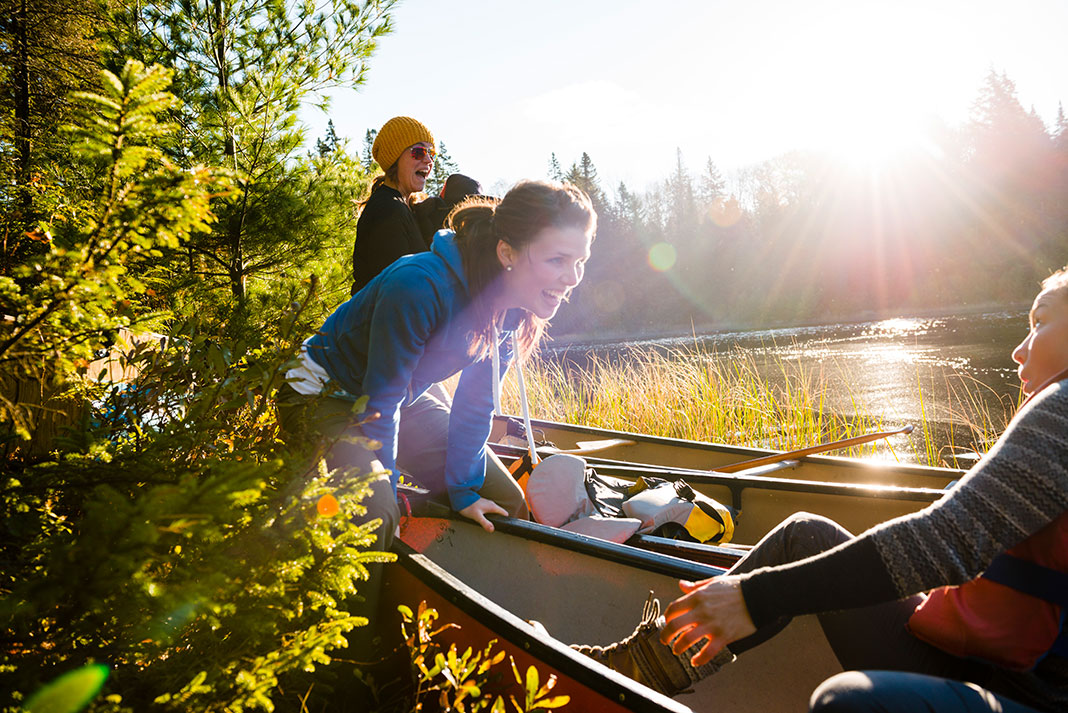
Camping in Algonquin Park
Looking to experience the magic of an overnight visit to Algonquin Provincial Park for yourself? Camping is one of Algonquin Park’s most popular activities, and camping opportunities are grouped into two main categories: drive-to campgrounds and backcountry campsites. Algonquin offers over 1,300 developed campsites accessible to vehicle and RV campers, as well as more than 1,900 canoe camping and backpacking sites spread across the park’s vast interior.
Drive to campgrounds in Algonquin Park
Each of Algonquin Park’s 11 developed campgrounds is situated beside an unspoiled lake and nestled amid the park’s famous hardwood and pine forests. Services vary by campground, with camping experiences for tent, RV and yurt campers. Eight of the park’s vehicle-accessible campgrounds are centrally located along Algonquin’s popular Highway 60 corridor. The lightly traveled north side of the park offers two developed campgrounds, while visitors to the east side of Algonquin will find one option for vehicle camping there. Learn more about the most Breathtaking Campgrounds in Algonquin Park.
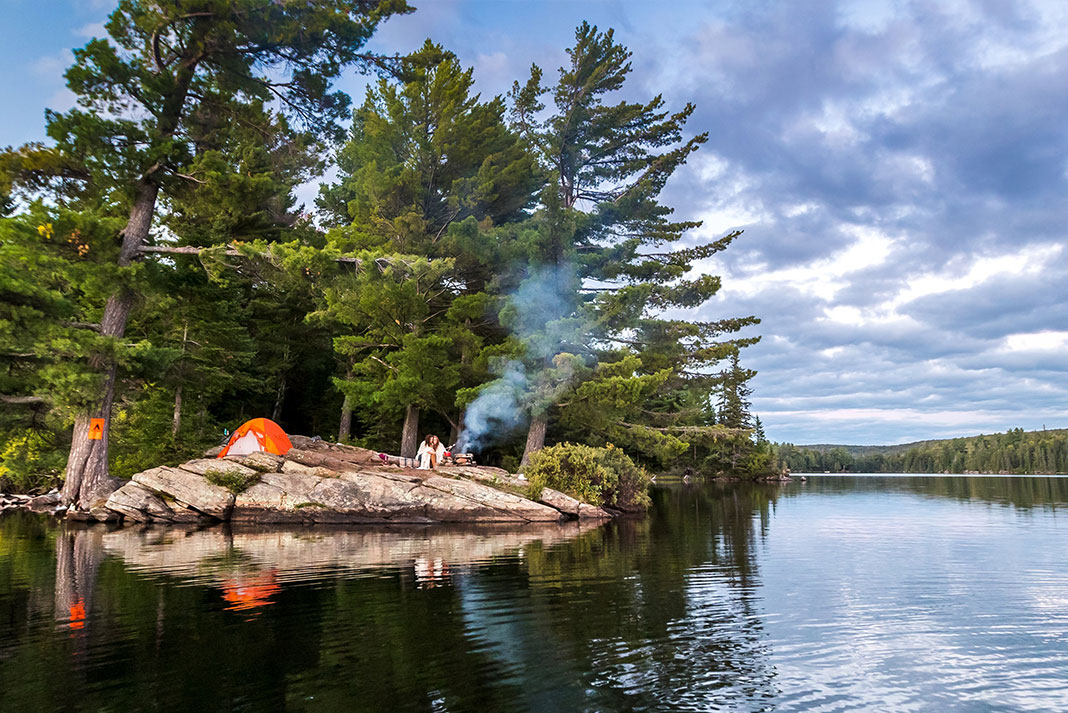
Backcountry camping in Algonquin Park
Experience Algonquin Park at its most rugged and wild—enter the backcountry by paddle and portage to sample a vast landscape of maple hills, rocky ridges, spruce bogs and thousands of lakes, ponds and streams. Additionally, Algonquin has three backpacking trails that await those seeking seclusion in the park on foot. Learn more about the best backcountry camping areas and how to Plan Your Dream Algonquin Backcountry Camping Trip.
View this post on Instagram
Hiking in Algonquin Park
Hiking trails in Algonquin Park run the gamut from easy rambles for first-time hikers, to demanding multi-day circuits for the most ambitious backpackers. Along the park’s Highway 60 corridor, you’ll find 14 interpretive hiking trails exploring different aspects of Algonquin Park’s diverse landscapes, geology, ecology, history, plants and animals.
Day hiking trails in Algonquin Park range from less than 1 kilometre to 11 kilometres in length. The park’s three backpacking trail networks offer a total of 140 kilometres of backcountry hiking.
View this post on Instagram
For a terrific introduction to hiking in Algonquin Park, don’t miss these top trails:
Lookout Trail – This moderate, 1.9-km trail is relatively steep and rugged but affords the hiker with a magnificent view of several hundred square kilometers of Algonquin Park. Especially gorgeous in the fall when the park’s hardwood forests blaze with color.
Barron Canyon Trail – Located amid pine forests on Algonquin Park’s east side, this moderate, 1.5-km trail leads to and runs along the north rim of the spectacular 100-meter-deep Barron Canyon. The interpretive trail guide explains the formation and history of the canyon.
Track and Tower Trail – For a longer day hike with a spectacular lookout as your reward, lace up your boots and tackle this moderate, 7.7-km looped trail.
Visit Ontario Parks to discover more hiking trails in Algonquin Park.
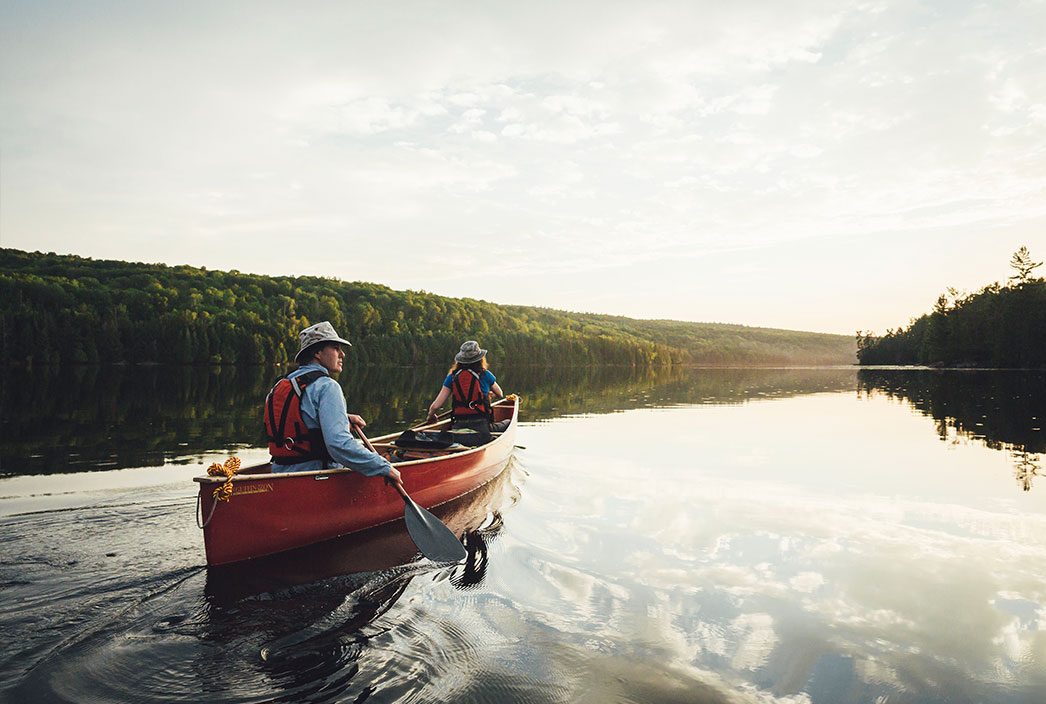
Canoeing in Algonquin Park
Whether you have single day or a whole week, canoeing in Algonquin Park is the definitive way to experience this iconic destination. Paddle around a misty lake at dawn, or venture deep into the park’s interior by paddle and portage. The longer your trip and the more portages you cross, the fewer other park visitors you’ll see.
First time paddling a canoe? Not to worry—many of the best Algonquin canoe routes are also offered as guided canoe trips by experienced park outfitters.
Alternatively, Algonquin Park Canoe Rentals are available at popular backcountry access points to make your journey from parking lot to paddling route quick and easy. Many outfitters also offer delivery to other access points or even right to your Algonquin Park campground. Shuttle service, camping equipment rental and full outfitting packages for self-guided canoe trips are also available.
View this post on Instagram
With over 2,000 kilometres of canoe routes, the paddling possibilities in Algonquin Park are almost infinite. Take the guesswork out of planning—discover the Best Canoe Routes and Trips in Algonquin Park for paddlers of every ability and appetite.
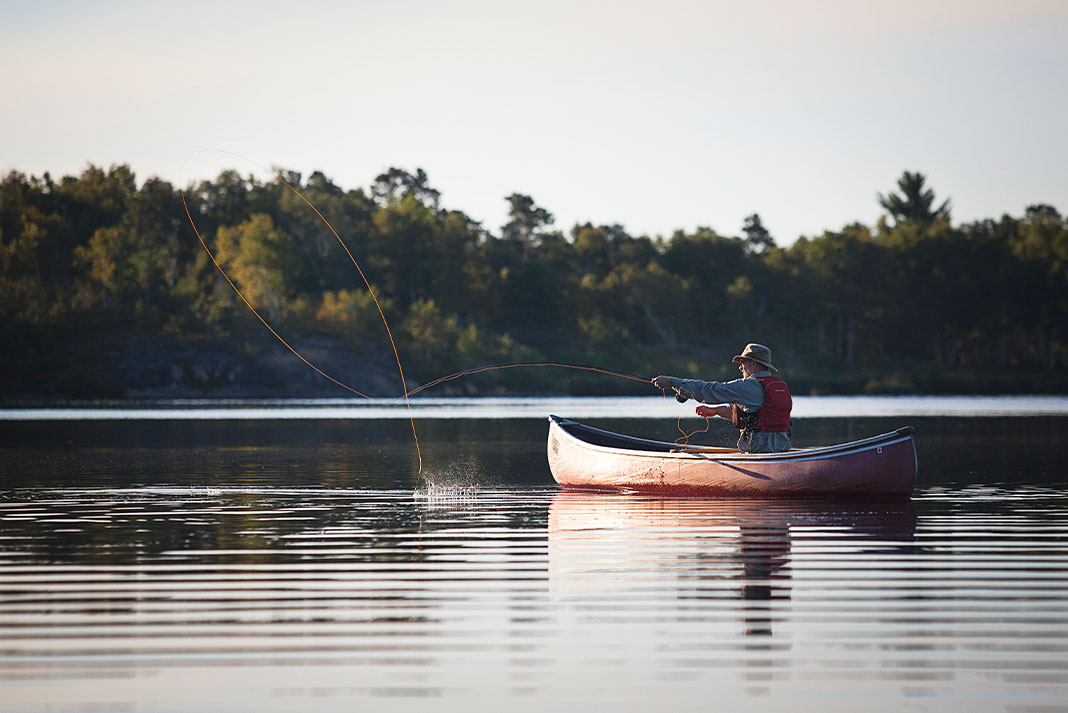
Fishing in Algonquin Park
No less than 54 different species of fish have been recorded in Algonquin Park, but it’s the world-class trout fishing that draws many anglers from across Ontario and beyond. Algonquin is home to the highest concentration of native brook (speckled) trout lakes in the world.
Algonquin’s outstanding fisheries owe their existence to the park’s rare combination of headwater lakes and rivers, seclusion and protection from development. Many of Algonquin Park’s more than 1,500 lakes and 1,200 kilometres of streams and rivers lie in the backcountry, and see only a small number of anglers each year. Lakes along the Highway 60 corridor, where fishing pressure is higher, have special regulations to ensure their populations are not overfished.
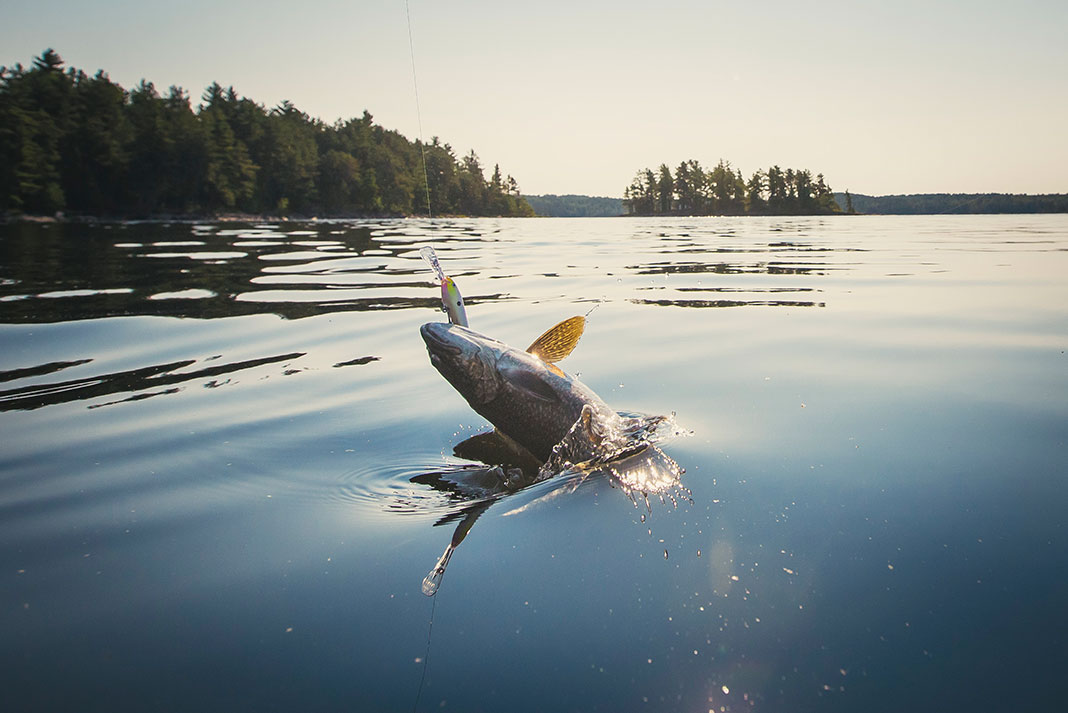
Anyone can enjoy an Algonquin Park fishing trip—whether you’re a first-time fisher feeling the tug of summer smallmouth on your line, or an avid angler targeting wary brook trout in secret backcountry streams. Learn more about Algonquin Park Fishing: Everything You Need to Know.
View this post on Instagram
Winter activities in Algonquin Park
Winter is a special time of year in Algonquin Park, when frosty temperatures and heavy snowfall bring solitude to park trails. Spectacular winter vistas and intimate wildlife encounters reward warmly dressed photographers, while enthusiasts of winter activities will find plenty to do and explore. Highway 60 is ploughed and sanded all winter and many trails are available for winter visitors.
Cross-country skiing
Three Algonquin Park ski trail networks offer over 110 kilometers of some of Ontario’s best cross-country (Nordic) skiing. These trails are groomed and trackset on a regular basis throughout the winter season, and feature warming cabins equipped with woodstoves. Backcountry skiers will also find an ungroomed trail network for wilderness skiing adventures. Ski rentals are available from Algonquin Outfitters locations in Huntsville and Oxtongue Lake (Dwight).
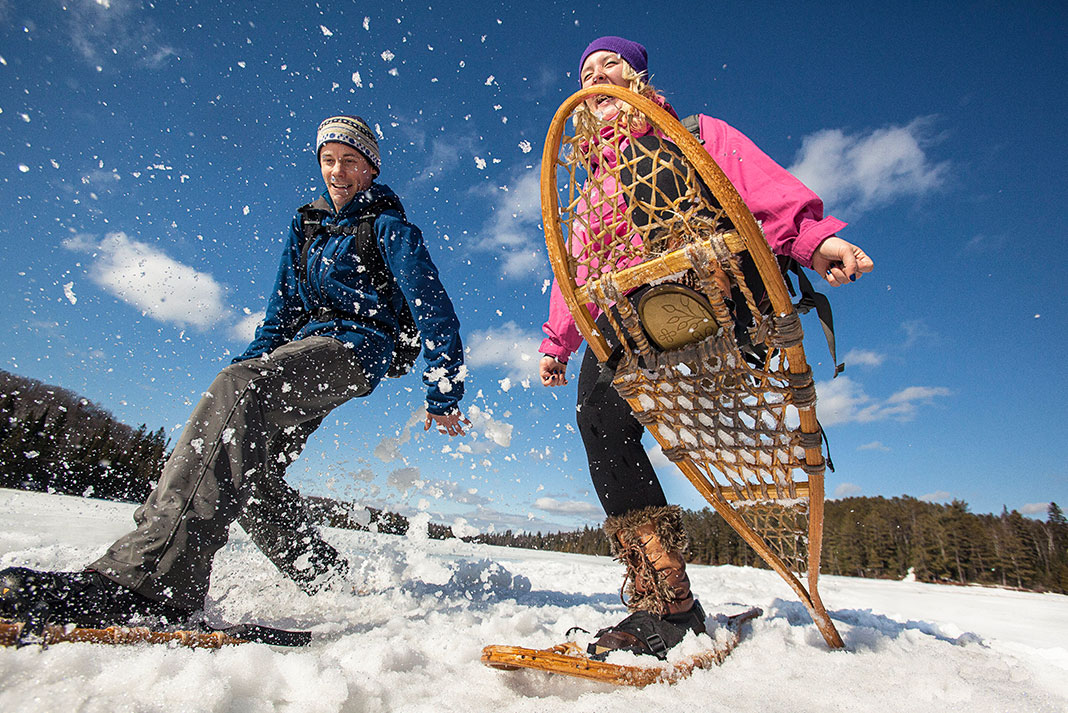
Snowshoeing
Snowshoeing enthusiasts can go virtually anywhere within the park except on cross-country ski trails. Try one of the short hiking trails along the Highway 60 corridor for an easy winter outing. Snowshoe rentals are available from Algonquin Outfitters locations in Huntsville and Oxtongue Lake.
Fat biking
Algonquin Park’s Old Railway Bike Trail is groomed approximately 12 km from Pog Lake to Cache Lake throughout the winter as a multi-use recreation trail that is popular for fat biking. Fat bike rentals are available in Huntsville at Algonquin Outfitters.
Dogsledding
Dogsledding opportunities, offered by commercial operators, are available in two locations in the park—the Sunday Lake Dogsled Trail network accessed from Highway 60, and the North Algonquin Dogsled Trail accessible from the town of South River on Highway 11.
Winter camping
Algonquin Park offers a variety of winter camping experiences, including backcountry camping and developed vehicle, RV and heated yurt camping at Mew Lake Campground.
Visit Ontario Parks to learn more about winter recreation in Algonquin Park.
Day trips and tours in Algonquin Park
Get closer than you imagined possible to Algonquin Park moose, photograph the park’s most stunning autumn scenes, or discover cultural treasures hidden deep in the forest. From Algonquin canoe tours to photography workshops, driving and bus tours, you’ll be amazed by how much you can see and learn on an Algonquin Park day trip.
View this post on Instagram
Algonquin Park canoe tours
Join a guided Algonquin Park canoe tour for a great introduction to paddling in the park. Perfect for first-timers, these day trips include canoes, paddles, safety equipment, park permits and a tasty shore lunch. Enhance your Algonquin canoe tour by choosing a themed day trip based on your interests—wildlife watching, artists in the park, fishing and more.
View this post on Instagram
Algonquin Park photography tours
Whether you’re an avid photographer looking to expand your knowledge of wildlife and landscape photography, or a novice shutterbug wanting to capture quintessential images from your time in the park, there is an Algonquin Park photo tour that is sure to develop your skills.
Algonquin Park driving and bus tours
An Algonquin Park bus tour or driving tour can be a great introduction to the park for first-time visitors. Highway 60 traverses Algonquin from east to west, a twisting two-lane road that winds through nearly 60 kilometres of amazing scenery, past sparkling lakes and vibrant forest.
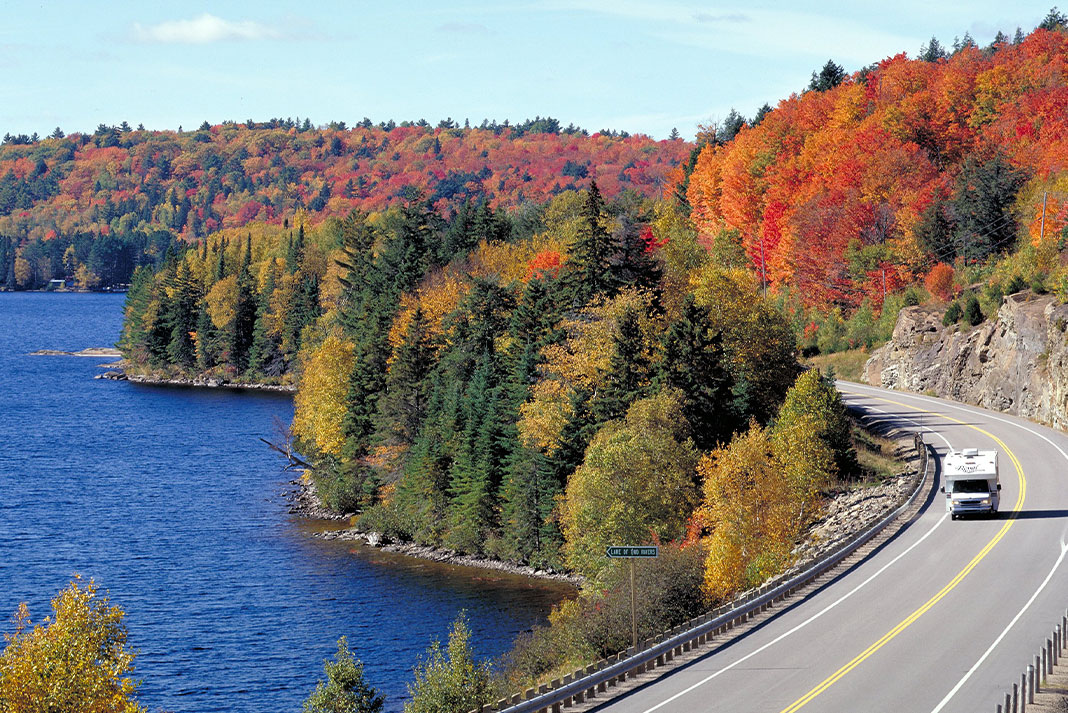
Most bus tours make several stops throughout the day at some of Algonquin Park’s top attractions. Many tours include time for easy, optional hikes on scenic lookout trails. There are even adventurous Algonquin bus tours for active travellers that include canoeing excursions, swimming in a pristine lake and longer hikes.
Discover 17 Of The Best Guided Tours In Algonquin Park.
Multi-day tours in Algonquin Park
Experience the beauty and tranquility of Algonquin Park’s wild interior on a guided multi-day tour of the park with an esteemed local outfitter. Learn paddling, portaging and camping skills while traveling one of Algonquin’s spectacular backcountry canoe routes on a guided multi-day canoe trip.
In winter, a lodge-based tour offers an immersive yet comfortable snow-season experience. For the ultimate winter adventure, join a multi-day dogsledding tour across the frozen backcountry, staying in rustic winter camps.
Places to visit in Algonquin Park
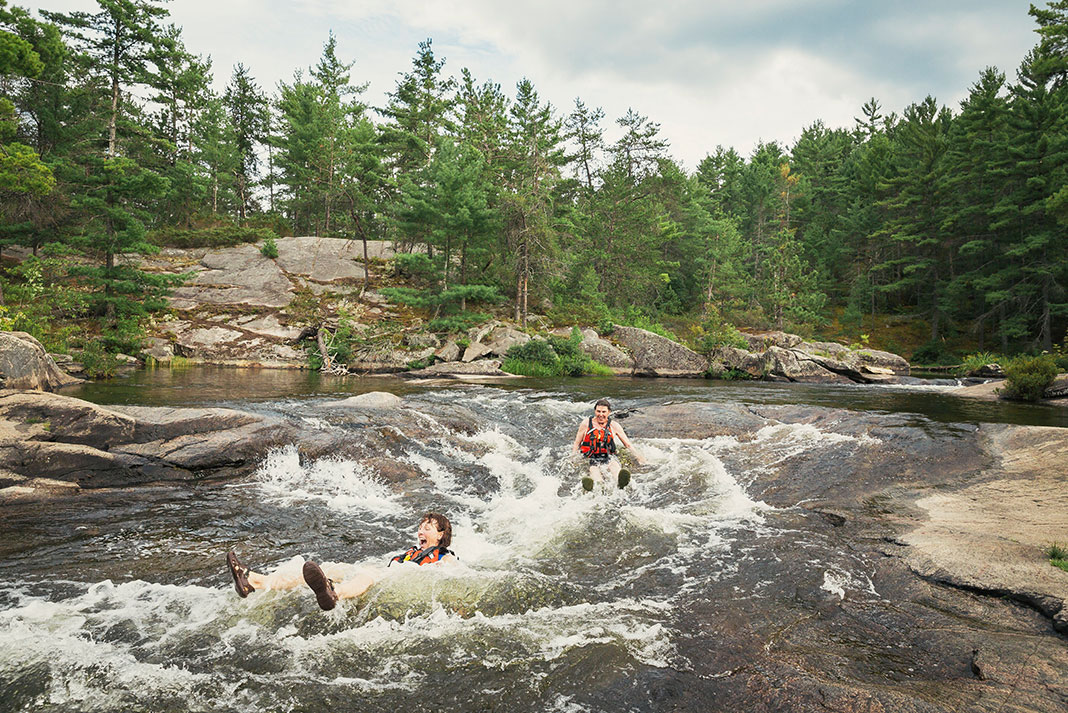
Algonquin High Falls
Take a wild ride on a natural water slide! Algonquin Park’s High Falls is the perfect place to cool off on a hot day. Pack your swimsuit and a picnic lunch for an exciting afternoon of sliding and splashing down this natural rock water slide.
The High Falls water slide is located on the eastern edge of Algonquin Park, accessible from Barron Canyon Road and Achray Access Point on Grand Lake. There are a number of ways that hikers, canoeists, kayakers and paddleboarders can reach the slide, including an easy walking trail or a short paddle down Stratton Lake. Interior backpacking and canoeing campsites near the falls invite a longer stay.
Plan your visit to Algonquin Park’s #1 Waterslide.
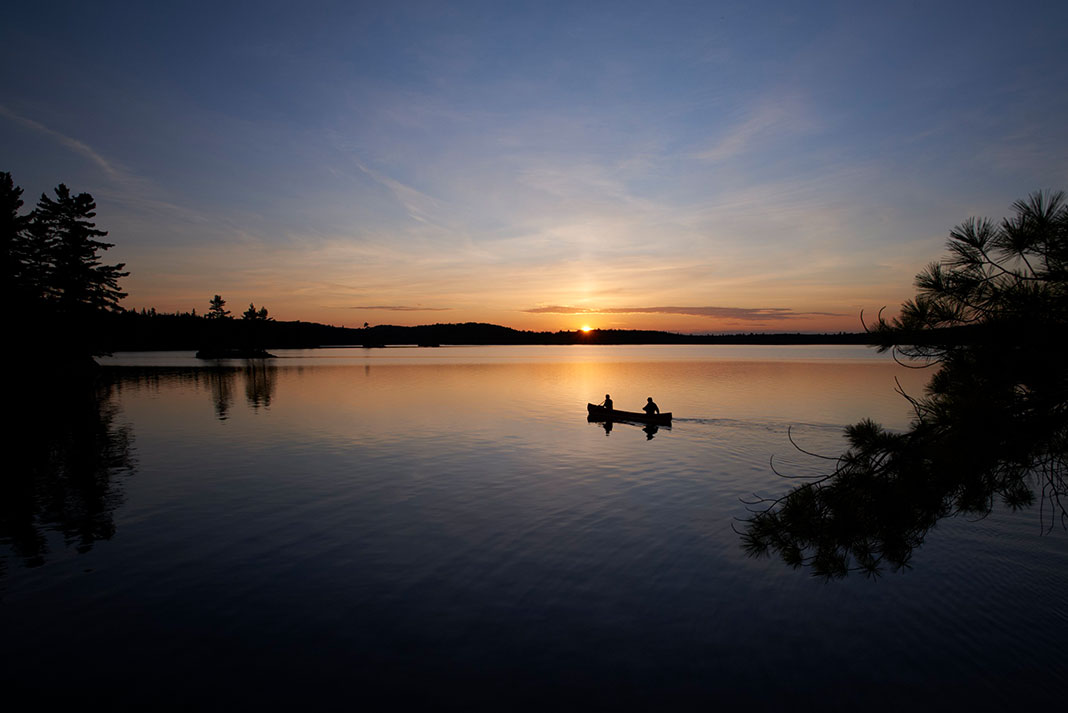
Algonquin Park lakes
With more than 1,500 lakes to choose from, shortlisting Algonquin Park’s finest lakes is no easy task. Sandy beaches, perfect rock points, unbelievable fishing, stellar swimming holes and private island camping—Algonquin Park lakes have it all.
To create this bucket list of 21 Stunning Lakes in Algonquin Park, we factored in each lake’s exceptional scenic value, as well as its ease of access for paddlers and hikers, and what else you can see in the surrounding area. We also selected lakes with above-average campsites, so you can spend as much time soaking up those lakefront views as you like.
Barron Canyon
Algonquin Park’s Barron Canyon is so jaw-droppingly beautiful, it’s well worth seeing from every angle. For a brief period after the end of the last ice age, the Barron River carried the entire outflow from Lake Aggasiz (the precursor of today’s Great Lakes) and a spectacular canyon was cut by this tremendous flow of water.
To experience the 100-meter-deep canyon from its depths, paddle up the Barron River from eastern Algonquin’s Squirrel Rapids access point. Towering white pines on the gorge’s rim appear like toy trees from this vantage point. This 1-day canoe trip requires two short portages and is suitable for both novice and expert paddlers.
Retrace your paddle strokes back to your vehicle, and then hike the Barron Canyon Trail to catch the equally breathtaking view from the top. This moderate, 1.5-km trail runs along the north rim of the canyon beside precipitous cliff tops—watch your step.
Algonquin Park backcountry
The best way to experience Algonquin Park’s vast backcountry is by undertaking a multi-day trip into the park’s interior, staying at canoe campsites, backpacking campsites or one of a handful of backcountry ranger cabins within the park.
Explore some of the Best Canoe Routes in Algonquin Park for backcountry trips ranging from 2 to 7 days.
And find your perfect backcountry campsite in the Guide To Planning A Backcountry Camping Trip In Algonquin.
Where to stay in Algonquin Park
Camping in Algonquin Park
Together, Algonquin Park’s 11 developed campgrounds offer more than 1,300 campsites accessible to tent, vehicle and RV campers. Algonquin Park campgrounds are located beside lovely lakes, with a wide range of amenities including electrical hook-up, comfort stations with hot showers, swimming beaches and even yurt rentals. Eight of the park’s vehicle-accessible campgrounds are centrally located along Algonquin’s popular Highway 60 corridor. Learn more about Camping in Algonquin Park: 9 Breathtaking Campgrounds.
Hotels near Algonquin Park
A diverse selection of comfortable and affordable hotels is located within minutes of Algonquin Park’s west, east and southern access points. Algonquin inns and hotels are ideal for those wanting modern amenities and comforts while enjoying easy access to Algonquin Park’s outdoor recreation opportunities. Plus, many hotels offer the convenience of a room or fully equipped suite that is steps from the shops and restaurants of the region’s welcoming communities. Discover 13 Algonquin Hotels For People Who Don’t Want To Camp.
View this post on Instagram
Algonquin Park cottages & cabins
Rent a restored Algonquin log cabin for an authentic heritage experience in the park’s interior, or choose a modern Algonquin cottage rental for a family staycation everyone will love. Whether you’re after an off-grid getaway or something more deluxe, these stunning properties make inviting and convenient bases for exploring the park’s breathtaking natural beauty. Find 25 Charming Cottage And Cabin Rentals Near Algonquin Park.
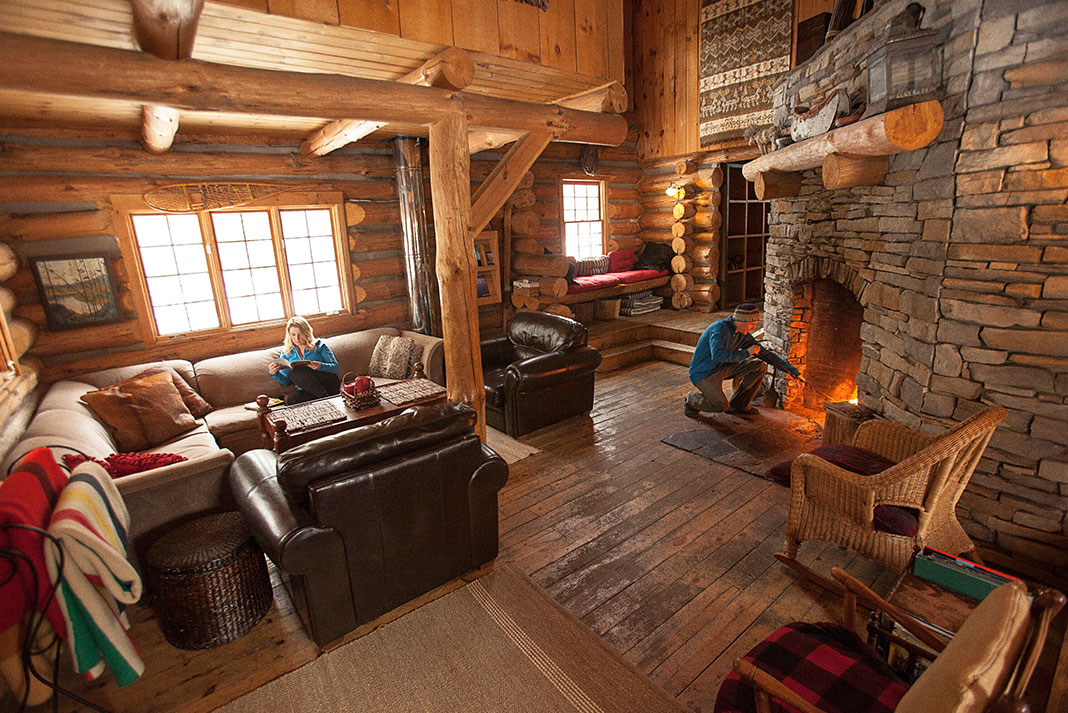
Algonquin Park lodges & resorts
An Algonquin lodge stay offers flexibility for couples, friends, families and solo travellers. Book an all-inclusive package where every detail of your experience is exquisitely crafted. Or go independent—exploring the scores of trails, lakes and attractions just a short drive from your doorstep, and then returning to your peaceful refuge to recharge for the next adventure. Choose from a wide variety of lodges and resorts located within the park’s boundaries or on its periphery. Base yourself at an Algonquin lodge or resort for a true holiday feel with a comfortable cocktail of rustic luxury and wilderness vibes. Discover 19 Rustic to Classic Lodges and Resorts Near Algonquin Park.
Algonquin Park weather
Weather in Algonquin Park varies greatly depending on which season you are planning to visit. During peak summer season (late June through early September), Algonquin Park enjoys hot, humid days, warm nights and plenty of sunshine. Afternoon thunderstorms can bring heavy rain, but are usually short-lived. The average daily high is 20–30°C.
Spring (May–June) is generally cooler and wetter, while fall (mid-September through October) offers a mix of bright sunshine, chilly rains and crisp nights.
If you are planning to paddle during your visit, water temperature is just as important a consideration as air temperature. In summer, Algonquin lakes are a comfortable swimming temperature, while water temperature in spring and fall is dangerously cold.
Winter (December–March) can be a magical time to visit Algonquin Park—for those equipped for frigid weather. In February, the coldest month in the park, the average daily high is just -10°C and overnight temperatures can drop below -30°C.
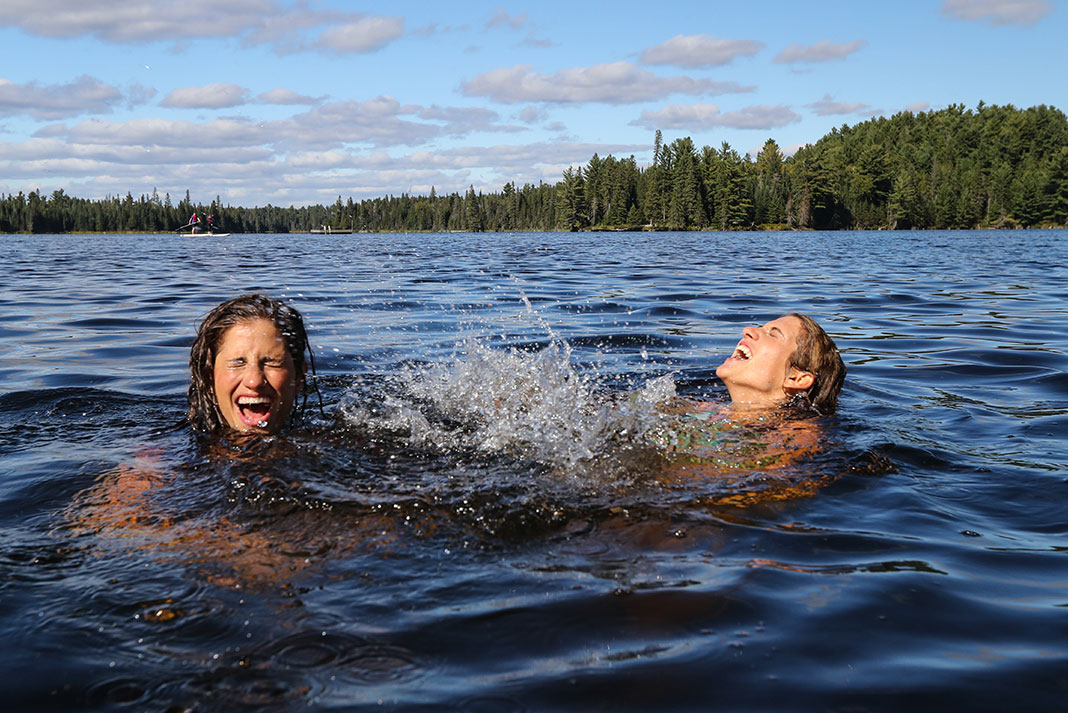
Algonquin 14-day, 7-day and hourly weather forecast
Get hourly, weekend, 7-day and 14-day weather forecasts for Algonquin Park at The Weather Network. Their forecast also includes a handy Bug Activity Report—so you can avoid visiting the park when biting insects are at peak activity.
Environment Canada offers two Algonquin Park forecasts: one for Lake of Two Rivers along the Highway 60 corridor, and one for Brent access point in the northern portion of the park.
For detailed weather trends, conditions and webcams in Algonquin Park visit the Friends of Algonquin Park.
Algonquin ice-out history
Over 50 years of record keeping in Algonquin Park show the average ice-out on Lake Opeongo—the park’s largest lake and usually the last to open up in the spring—is April 28, with dates ranging from late March to mid-May some years. Algonquin “Ice-out” refers to the day when a boat can travel the length of Lake Opeongo unimpeded by ice.
Generally, lakes on the lower and warmer east side of the park, and those with substantial water flow, are the first to shed their ice cover. The last lakes to melt are those in the higher elevation areas of the west side of Algonquin and the park’s largest lakes.
For current ice conditions in Algonquin Park and Algonquin Ice-out history, visit the Friends of Algonquin Park.
Getting to Algonquin Park
View this post on Instagram
Toronto to Algonquin Park
Algonquin Park’s West Gate is the closest park entrance to Toronto, located some 260 km (160 miles) north of the city.
Traveling by car, the most direct route is a 3-hour drive on Highway 400/Highway 11 north to the Huntsville area, and then east on Highway 60 to the West Gate park entrance.
The best way to get to Algonquin Park from Toronto without a car is to travel by bus. Parkbus offers one-way and return service from Toronto to popular locations along the park’s Highway 60 corridor. Travel is aboard a coach bus and takes around 4 hours to reach the West Gate. Find pricing and a detailed schedule here.
There are no options for air travel from Toronto directly to Algonquin Park.
Ottawa to Algonquin Park
Algonquin Park’s East Gate offers the closest entry point to the park’s popular Highway 60 corridor from Ottawa, a distance of 240 km (150 miles).
Most travellers from Ottawa arrive by car via Highway 417/Highway 60 West to the East Gate park entrance—a 2-hour and 45-minute drive. The eastern edge of the park is also popular with visitors from Ottawa. To reach Algonquin’s Achray/Grand Lake access point by car, drive 208 km (130 miles) on Highway 417/17 West to the Petawawa area and continue west on Barron Canyon Road.
The best way to get to Algonquin Park from Ottawa without a car is to travel by bus. Parkbus offers one-way and return service from Ottawa to popular locations along the park’s Highway 60 corridor. Travel is aboard a mid-size coach bus and takes around 3 hours and 40 minutes to reach Algonquin’s Lake Opeongo access point. Find pricing and a detailed schedule here.
There are no options for air travel from Ottawa directly to Algonquin Park.
Wildlife in Algonquin Park
View this post on Instagram
Bears in Algonquin Park
Although black bears are reasonably common in Algonquin Park, with the population thought to be around 2,000, bears are normally shy of humans and you will have to be very lucky to see one. However, careless food storage or improper disposal of garbage may attract bears looking for an easy meal, leading to “problem” bears that can become persistent and destructive nuisances. As a visitor camping in bear country, you have a responsibility to follow black bear safety rules and to know what to do if you encounter a bear.
View this post on Instagram
Moose in Algonquin Park
For many visitors to Algonquin Park, seeing a moose is at the top of their park wish lists. Fortunately, Algonquin’s long-legged mascot is one of the most commonly seen large mammals in the park. In spring, moose are attracted to roadsides along Highway 60 to feed on the new sprouting plants in the ditches and open areas. Increase your chances of seeing moose by concentrating on low-lying, wet areas such as bogs, ponds and beaver meadows, and visiting these areas in the early morning and evening. Spotting a moose from your canoe while exploring some of the park’s waterways is a highlight of any visit.
View this post on Instagram
Birding in Algonquin Park
With over 270 bird species recorded in Algonquin, there is no shortage of bird watching opportunities. For those wishing to learn more about the biology and ecology of 77 of the most striking birds that you can expect to find in Algonquin Park, pick up a copy of the Birds of Algonquin Provincial Park. Order this publication from The Friends of Algonquin Park or purchase it at various locations within the park.
Algonquin park maps
Every Algonquin Park visitor wants to experience the park’s iconic lakes, trails and campgrounds, but Algonquin’s sprawling geography makes it challenging to know where to start. Add to its immense size the fact that only a small fraction of the park is accessible from the main Highway 60 corridor, and a detailed, easy-to-use Algonquin Park map becomes just as essential as a good pair of hiking boots.
Google Maps and other mapping apps can give you a general idea of where to find Algonquin Park access points and specific attractions, but aren’t suitable for navigating in the backcountry. To explore on the ground, find the best maps by reading Don’t Get Lost In The Woods: A Guide To Algonquin Park Maps.


